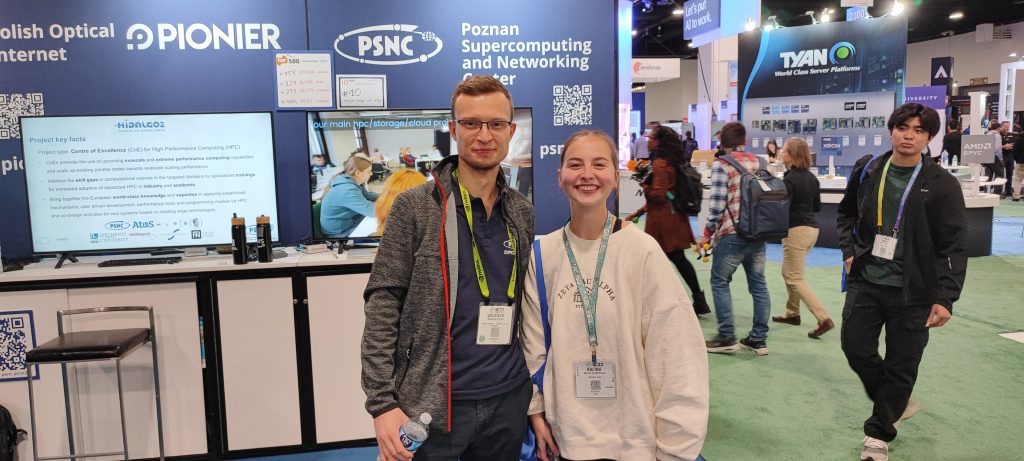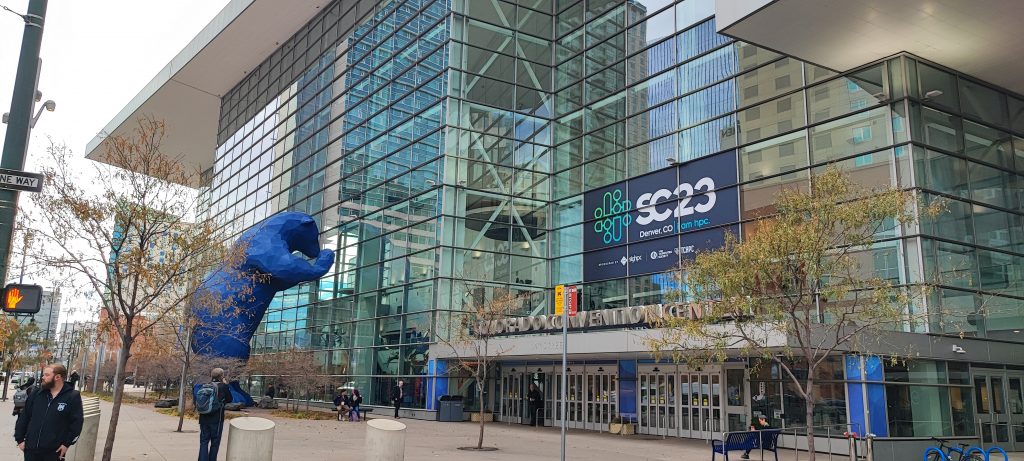HiDALGO2 was thrilled to be among the EuroHPC Joint Undertaking’s European projects that took part in one of the largest annual international HPC forums, the “International Conference for High-Performance Computing, Networking, Storage, and Analysis” or SC23 in Denver, USA, on 12-17 November 2023. Read about our key takeaways and the experiences of our partners who joined the event physically.

HiDALGO2 had the honour to present a short demonstration video that unfolds the aims and goals of the project and presents the main facts, the partners, the duration, the funding, etc. at the EuroHPC Joint Undertaking’s booth, in which many European projects were also hosted.

Our partners from High-Performance Computing Center Stuttgart (HLRS) and Poznan Supercomputing and Networking Center (PSNC) participated in SC23 with their organisations’ booths exhibiting the HiDALGO2 project among their other works. Namely, Wojciech Szeliga from our project coordinator, PSNC, and Dennis Hoppe, HiDALGO2’s technical manager working at HLRS took part and reported their experiences with us.
“The future of benchmarks for HPC systems was discussed in panels and other sessions. The usual suspect benchmarks such as LINPACK, which forms the basis for the Top500 ranking, are unrealistic according to many.”
Dennis Hoppe HLRS

Photo: Dennis Hoppe from HLRS
The ins and outs of the SC23
With a record number of attendees — more than 14,000 — experts, researchers, vendors, and enthusiasts in the field of HPC, this was the biggest SC23 ever. The booths with companies that specialise in AI and Quantum Computing were very visible. The top 500 list as of November 2023 was presented with LUMI being now at rank 5 worldwide and being the largest system in Europe. Moreover, LUMI won the HPCWire Award for the “Top Energy-Efficient HPC Achievement”.
Additionally, the future of benchmarks for HPC systems was discussed in panels and other sessions. The usual suspect benchmarks such as LINPACK, which forms the basis for the Top500 ranking, were unrealistic according to many participants. We are seeing a shift towards workflows executed on HPC systems that consist of multiple tasks. In addition, classic benchmarks only test HPC systems for very specific problems. The MLPerf benchmark for machine and deep learning, on the other hand, is a benchmark suite consisting of many different benchmarks for different use cases and, therefore, reflects much better what will be executed on a system in the future. It is worth considering whether a benchmark suite should be introduced to reorganise the Top500.
Another topic discussed was mixed precision. Whereas classical simulations (especially from the engineering domain) require high accuracy and thus are executed with 64 bits, many machines and deep learning models are trained at much lower precision (e.g., 8 or 16 bits). Having lower precision results in higher performance. Panel discussions focused on this topic. To further maximise performance, one could, for example, work with mixed precision for classical simulations: input and output are guaranteed to be 64bit, but within some core routines of the simulation, one reduces the precision to 32 or 16bit for faster processing. Here, new mathematical models are required to guarantee accuracy and reduce errors.

Photo: Wojciech Szeliga from PSNC
Our partners in HiDALGO2 had the pleasure of taking part in the SC23, where the scale of the event and the number of companies presenting their profiles and activities were astonishing.The conference allowed them to get up-to-date insight into such areas as AI, quantum computing, liquid cooling, new technologies of storage and networking, and more. Our partners from PSNC were glad that their booth attracted so much attention while the guests represented multiple companies and universities. Namely, the HiDALGO2 project was among their (PSNC’s) exhibition, and was reported that it gathered visitors interested in fine-grained weather forecasting addressing rapid climate change problems as well as related data management and storage. For example, there was a visitor from USGS (United States Geological Survey), the institution that gathers and publishes databases that we use in our numerical weather predictions for renewable energy sources in HiDALGO2.
“I truly enjoyed the event as well as our stay in Denver and I am looking forward to taking part in the next editions!”
Wojciech Szeliga -PSNC
About SC23

Established in 1988, the annual SC has built a diverse community of participants including researchers, scientists, application developers, computing center staff and management, computing industry staff, agency program managers, journalists, and congressional staffers. This diversity is one of the conference’s main strengths, making it a yearly “must-attend” forum for stakeholders throughout the technical computing community. This year the invited speakers covered various topics from cyber infrastructure, to biomedicine, from genomics to the developing world, from education to the quantum world.
You can read more about the programme, the speakers, and the topics of SC23 here: http://sc23.supercomputing.org
You can watch the HiDALGO2 video here: https://www.youtube.com/watch?v=cAK5-kSaJyM
Photo credits: SC23 website gallery, HiDALGO2
You can follow the HiDALGO2 project on our social media and stay up to date with all our updates.
Twitter: @HiDALGO2_EU
LinkedIN: @HiDALGO2
Sources:
- https://www.top500.org/lists/top500/2023/11/highs/
- https://www.llnl.gov/article/50646/record-setting-sc23-builds-mile-high-momentum-exascale-computing-ai-future-hpc
- https://www.hpcwire.com/off-the-wire/hpcwire-reveals-winners-of-the-20th-annual-readers-and-editors-choice-awards-during-sc23-conference/
- https://sc23.supercomputing.org/proceedings/bof/bof_pages/bof234.html
- https://sc23.supercomputing.org/proceedings/bof/bof_pages/bof130.html



